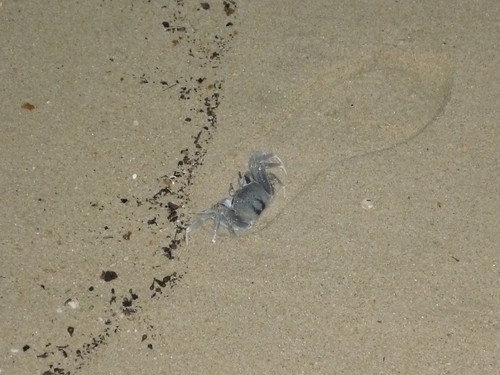
After my first seagrass monitoring session over at Tanjung Rimau, I decided to stay around and explore more of Siloso Beach. The tide was still low enough, and I thought that there more marine life might be out and about after dark. I headed for the bridge that would bring me to one of the islets across the lagoon. And before I had even started to cross the bridge, I found this ghost crab (Ocypode ceratophthalmus). This is the first time I've ever found one on Siloso Beach itself. These crabs are actually quite common on our beaches and sandy shores, but are very shy and come out only at night.
I was hoping that this would be a sign of all the exciting discoveries that lay ahead.
In the shallows, I see shoals of small fish, mostly young Kops' glass perchlet (Ambassis kopsii) and crescent perch (Terapon jarbua). They're too quick for me to even contemplate taking a photograph of them.
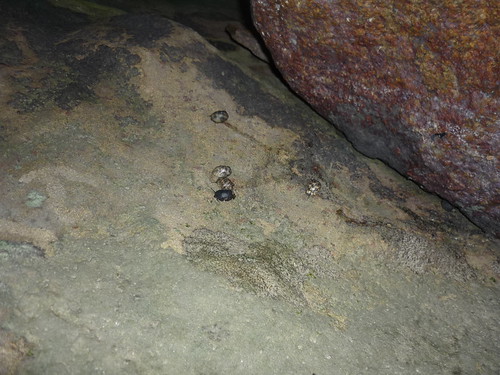
Here among the rocks, it looks as if the nerites are out in full force; they're crawling all over the place. I think these are Nerita undata.
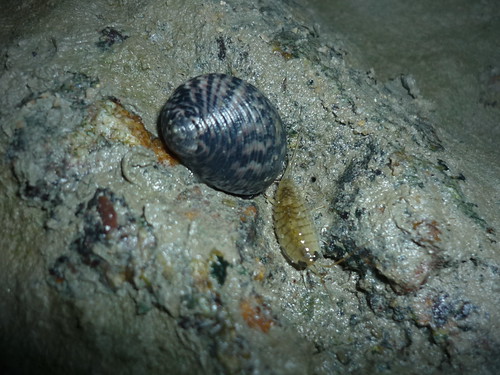
Here's a nerite and a sea slater (Ligia sp.) close together.
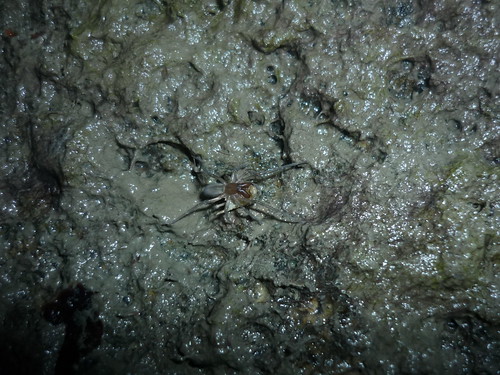
I've seen reef spiders (Desis sp.) many times on the coral rubble of Tanjung Rimau, but this is the first time I've seen one here in this lagoon. This one seems to have captured some sort of isopod.
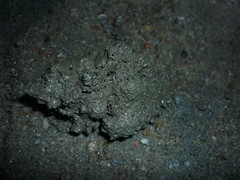

I think this snail is Chicoreus torrefactus, a predator that feeds on bivalves by drilling a small hole into the shell of its prey.
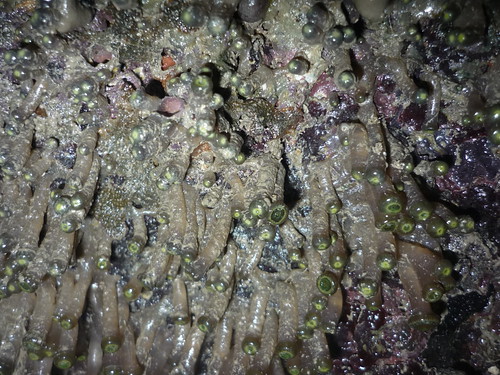
There's zoanthids growing beneath this rock.
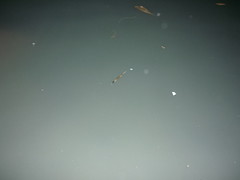

Young halfbeaks (F. Hemirhamphidae) can be seen near the surface.
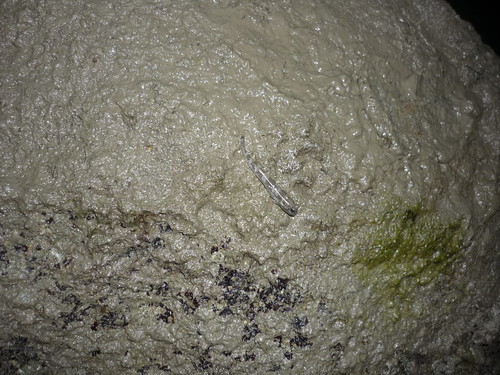
It's slightly easier to sneak up on mudskippers at night. This one's probably a dusky-gilled mudskipper (Periophthalmus novemradiatus).
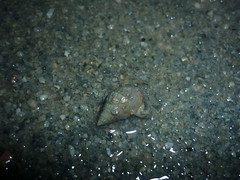

Whelks (Nassarius livescens) are commonly found patrolling the sand, but I wasn't expecting to find a live pearl conch (Laevistrombus canarium).
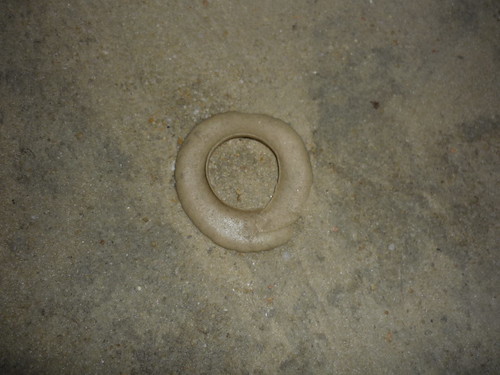
I've been finding sand collars regularly, but have yet to find any moon snails on this shore. Sand collars are the egg masses of moon snails, and are a mixture of mucus and sand.
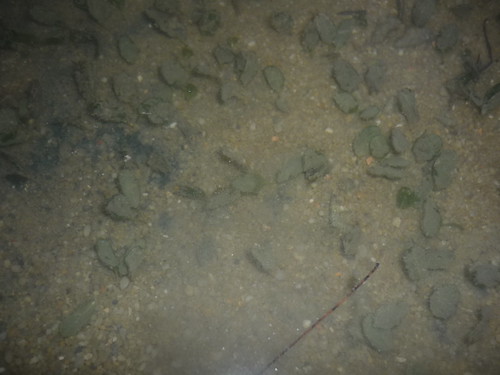
Close to the floating bridge, I'm shocked to stumble upon a small patch of spoon seagrass (Halophila ovalis)!
This is the most common species of seagrass found in Singapore, but I'm amazed that it manages to eke out a precarious existence in the murky waters of this lagoon.

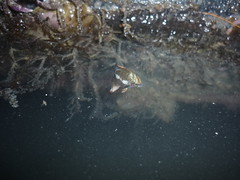
The bridge provides plenty of hiding places for young fish. The one on the left should be a young silver moony (Monodactylus argenteus), but I'm not so sure about the one on the right.
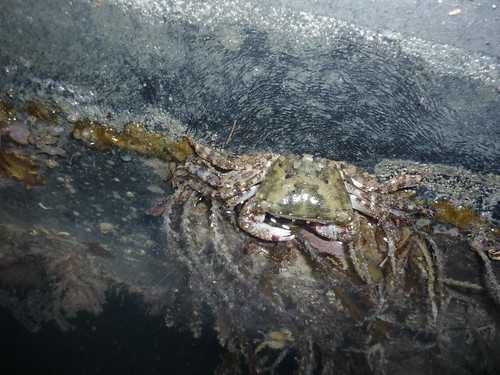
Every time I explore this bridge, I manage to spot purple climber crabs (Metopograpsus sp.).
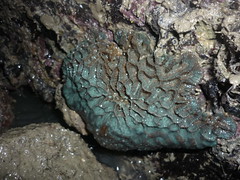
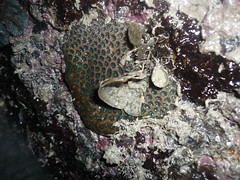
Among the rocks on one end of the islet, I discover not one, but two hard corals!
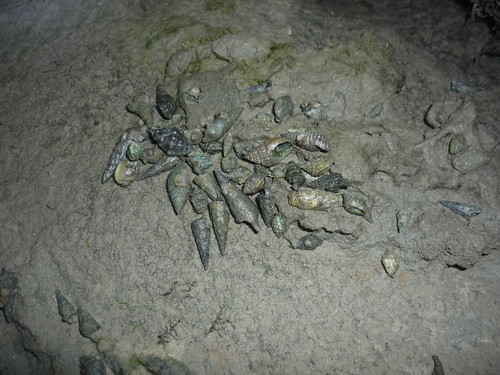
Here's a gang of tidal hermit crabs (Diogenes sp.), inhabiting an assortment of snail shells. I see creeper snails (Batillaria zonalis), three species of whelks (Nassarius livescens, N. crenoliratus and N. pullus), as well as a few drills (F. Muricidae). One way of finding out what snails live in an area is to check out what the hermit crabs are wearing.
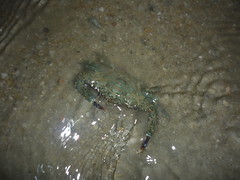
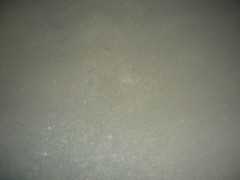
Swimming crabs (Thalamita sp.) and juvenile flower crabs (Portunus pelagicus) are often found in the shallows.
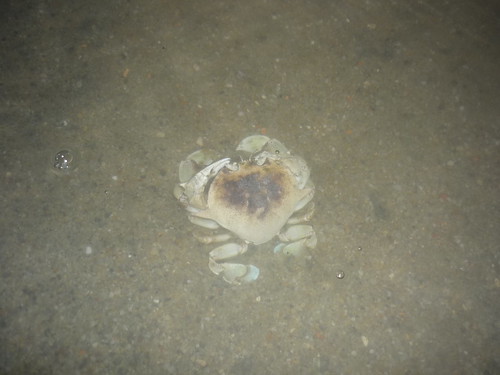
Not often seen though, are moon crabs. I'm not sure if this is the spotted moon crab (Ashtoret lunaris).

Here's another amazing find. A flatworm, swimming away! My expertise in flatworms is lousy, but I guess this could be a species of Pseudobiceros.
I took a short video. Isn't it graceful? These beautiful worms normally crawl around on the seabed, but as you can see, they're also capable of swimming.
Apologies for the video quality; my skills are nowhere close to those of Andy. Almost immediately after I stopped recording, a tiny squid, possibly the same species as the one I found earlier on in the afternoon, swam past. Damn.
But the most exciting discovery of the night overshadows even the flatworm. Last May, I'd found common sea stars (Archaster typicus) in the shallows of this very same islet. You can see my submission of this discovery over on STOMP.
Today, I was hoping to find them again.

The tide is rising, and the water's getting murkier. Just as I'm about to give up, I find one, half-buried in the sand.
Yes!
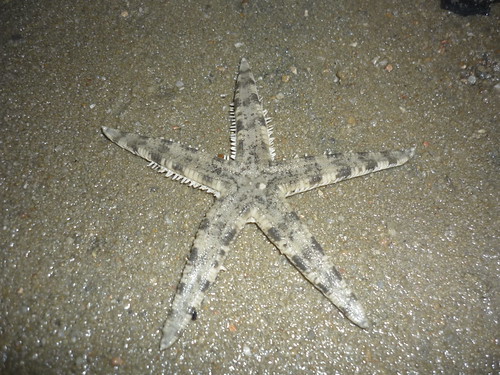
Here's another look. It's good to know that there's still at least one common sea star surviving on this shore. I hope there's many more in the deeper parts of the lagoon.
And so, after having spent an entire afternoon and evening on Sentosa, I head for home, exhausted, but absolutely thrilled at all the amazing discoveries I've made today. Who knew that one could find seagrasses, hard corals, flatworms, and sea stars in these seemingly barren swimming lagoons? I'm really keen on exploring Siloso Beach during a really low tide, and see what other treasures I might find.
This is part 2 of a 2-part series on a trip to Siloso Beach on 17th October, 2008.
Part 1: Siloso suntan
Part 2: Siloso: seagrass and sea stars (this post)